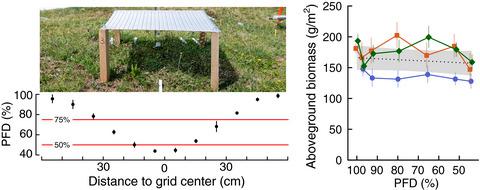当前位置:
X-MOL 学术
›
Glob. Change Biol.
›
论文详情
Our official English website, www.x-mol.net, welcomes your feedback! (Note: you will need to create a separate account there.)
Halving sunlight reveals no carbon limitation of aboveground biomass production in alpine grassland.
Global Change Biology ( IF 11.6 ) Pub Date : 2019-12-04 , DOI: 10.1111/gcb.14949 Patrick Möhl 1 , Erika Hiltbrunner 1 , Christian Körner 1
Global Change Biology ( IF 11.6 ) Pub Date : 2019-12-04 , DOI: 10.1111/gcb.14949 Patrick Möhl 1 , Erika Hiltbrunner 1 , Christian Körner 1
Affiliation

|
In temperate alpine environments, the short growing season, low temperature and a slow nutrient cycle may restrict plant growth more than carbon (C) assimilation does. To test whether C is a limiting resource, we applied a shade gradient from ambient light to 44% (maximum shade) of incident photon flux density (PFD) in late successional, Carex curvula-dominated alpine grassland at 2,580 m elevation in the Swiss central Alps for 3 years (2014-2016). Total aboveground biomass did not significantly decrease under reduced PFD, with a confidence interval ranging from +4% to -15% biomass in maximum shade. Belowground biomass, of which more than 80% were fine roots, was significantly reduced by a mean of 17.9 ± 4.6% (±SE), corresponding to 228 g/m2 , in maximum shade in 2015 and 2016. This suggests reduced investments into water and nutrient acquisition according to the functional equilibrium concept. Specific leaf area (SLA) and maximum leaf length of the most abundant species increased with decreasing PFD. Foliar concentration of nonstructural carbohydrates (NSC) was reduced by 12.5 ± 4.3% under maximum shade (mean of eight tested species), while NSC concentration of belowground storage organs were unchanged in the four most abundant forbs. Furthermore, maximum shade lowered foliar δ13 C by 1.56 ± 0.35‰ and increased foliar nitrogen concentrations per unit dry mass by 18.8 ± 4.1% across six species in 2015. However, based on unit leaf area, N concentrations were lower in shade (effect of higher SLA). Thus, while we found typical morphological and physiological plant responses to lower light, shading did not considerably affect seasonal aboveground biomass production of this alpine plant community within a broad range of PFD. This suggests that C is not a growth-limiting resource, matching the unresponsiveness to in situ CO2 enrichment previously reported for this type of grassland.
中文翻译:

将阳光减半表明,高寒草原地上生物量的生产没有碳限制。
在温带高山环境中,生长季节短,温度低和养分循环慢可能比碳(C)同化作用更限制植物生长。为了测试C是否是一种限制资源,我们在瑞士中部海拔2580 m的凯里斯弯弯曲曲晚期为主的高寒草地中,采用了从环境光到入射光子通量密度(PFD)的44%(最大阴影)的阴影梯度。阿尔卑斯山3年(2014-2016年)。在降低的PFD下,地上总生物量并未显着减少,最大阴影下的置信区间为+ 4%至-15%。地下生物量(其中80%以上是细根)在2015年和2016年的最大阴影下平均减少了17.9±4.6%(±SE),相当于228 g / m2。这表明根据功能平衡概念,减少了对水和养分获取的投资。随着PFD的减少,最丰富物种的比叶面积(SLA)和最大叶长增加。在最大遮荫下(八个被测物种的平均值),非结构性碳水化合物(NSC)的叶面浓度降低了12.5±4.3%,而在地下的储藏器官中,NSC的浓度在四个最丰富的前叉中未发生变化。此外,2015年最大遮荫使6个物种的叶片δ13C降低1.56±0.35‰,并使每单位干重的叶片氮浓度增加18.8±4.1%。更高的SLA)。因此,尽管我们发现了植物对低照度的典型形态和生理反应,遮荫并没有在很大范围的PFD中严重影响该高山植物群落的季节性地上生物量生产。这表明碳不是限制生长的资源,这与以前报道的这类草地对原位CO2富集的无响应性相匹配。
更新日期:2020-01-27
中文翻译:

将阳光减半表明,高寒草原地上生物量的生产没有碳限制。
在温带高山环境中,生长季节短,温度低和养分循环慢可能比碳(C)同化作用更限制植物生长。为了测试C是否是一种限制资源,我们在瑞士中部海拔2580 m的凯里斯弯弯曲曲晚期为主的高寒草地中,采用了从环境光到入射光子通量密度(PFD)的44%(最大阴影)的阴影梯度。阿尔卑斯山3年(2014-2016年)。在降低的PFD下,地上总生物量并未显着减少,最大阴影下的置信区间为+ 4%至-15%。地下生物量(其中80%以上是细根)在2015年和2016年的最大阴影下平均减少了17.9±4.6%(±SE),相当于228 g / m2。这表明根据功能平衡概念,减少了对水和养分获取的投资。随着PFD的减少,最丰富物种的比叶面积(SLA)和最大叶长增加。在最大遮荫下(八个被测物种的平均值),非结构性碳水化合物(NSC)的叶面浓度降低了12.5±4.3%,而在地下的储藏器官中,NSC的浓度在四个最丰富的前叉中未发生变化。此外,2015年最大遮荫使6个物种的叶片δ13C降低1.56±0.35‰,并使每单位干重的叶片氮浓度增加18.8±4.1%。更高的SLA)。因此,尽管我们发现了植物对低照度的典型形态和生理反应,遮荫并没有在很大范围的PFD中严重影响该高山植物群落的季节性地上生物量生产。这表明碳不是限制生长的资源,这与以前报道的这类草地对原位CO2富集的无响应性相匹配。


























 京公网安备 11010802027423号
京公网安备 11010802027423号